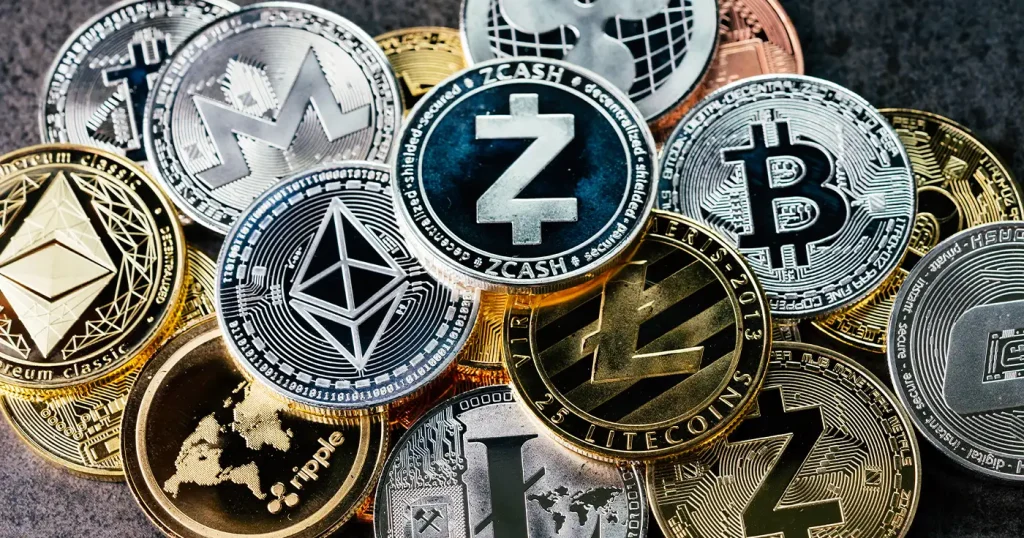Cryptocurrency Markets, Market Cap

What is cryptocurrency trading, and how does it work?
Cryptocurrency money exchange includes guessing on cost developments through a CFD exchange too record or trade the hidden coins through a trade. Here, you’ll find more data about cryptographic money exchange, how it works, and what moves the business sectors.
What is cryptocurrency?
Cryptocurrency is trading the fundamental coins through a trade.
Types of cryptocurrency
Following are the types of Cryptocurrency
Bitcoin
Ethereum
Tether
USD Coin
Binance Coin
Ripple
Cardano
Binance
Ethereum
Along With Ethereum is a decentralized worldwide programming stage controlled by blockchain innovation. It is generally regularly known by financial backers for its local digital money, ether (ETH), and by designers for its utilization in blockchain and decentralized finance application advancement.
Anybody can utilize Ethereum—it’s intended to be versatile, programmable, secure, and decentralized—to make any advanced innovation. Its token is intended to pay for work done supporting the blockchain, yet members can likewise utilize it to pay for substantial labor and products.
Is cryptocurrency legal?
In March 2020, the High Court of India passed a decision denying the RBI restriction on cryptographic money exchange. In 2021, the public authority is investigating the formation of a state-supported computerized cash given by the Reserve Bank of India while prohibiting private ones like Bitcoin.
CFD trading on cryptocurrencies
CFD trading is subsidiaries that empower you to estimate cryptographic money cost developments without taking responsibility for fundamental coins. You can go long (‘purchase’) if you figure a digital currency will ascend in worth or short (‘sell’), assuming you figure it will fall.
Both are utilized items, meaning you have to set up a little store—known as an edge—to acquire full openness to the hidden market. Your benefit or misfortune is as yet determined by the standard of your situation, so influence will amplify the two benefits and misfortunes.
Buying and selling cryptocurrencies via an exchange
When you purchase cryptographic forms of money through a trade, you buy the actual coins. You’ll have to make a trade account, set up the full worth of the resource to open a position and store the digital money tokens in your wallet until you’re prepared to sell.
Trades bring their lofty expectation to absorb information as the need might arise to hold with the innovation in question and figure out how to get a handle on the information. Many trades also limit the amount you can store, while records can be pricey to keep up with.
How Do Cryptocurrency Markets Work?
Cryptographic money markets are decentralized, and that implies they are not given or upheld by a focal power like an administration. All things considered, they stumble into an organization of PCs. Nonetheless, digital currencies can be traded using trades and put away in ‘wallets.’
Dissimilar to customary monetary forms, digital forms of money exist just as a common computerized record of proprietorship put away on a blockchain. At the point when a client needs to send cryptographic money units to another client, they send it to that client’s computerized wallet. The exchange isn’t viewed as lasting until it has been confirmed and added to the blockchain through a cycle called mining. This is likewise how new digital money tokens are typically made.
What is blockchain?
A blockchain is a common computerized register of recorded information. For digital currencies, this is the exchange history for each unit of the cryptographic money, which shows how proprietorship has changed over the long haul. It works by keeping exchanges in ‘blocks,’ with new blocks added at the front of the chain.
The innovation has novel security that typical PCs don’t have.
Blockchain Secure
Blockchain innovation accomplishes decentralized security and confidence in more ways than one. Too start, new blocks are constantly put away directly and sequentially. After a block has been added to the furthest limit of the blockchain, past blocks can’t be modified.
An Addition of any information changes the hash of the block it was in. Since each block contains the past block’s hash, an adjustment of one would change the accompanying blocks. The organization would, by and large, oddball an adjusted block because the hashes wouldn’t coordinate.
Network agreement
A blockchain record is constantly put away on various PCs across an organization—as opposed to in a solitary area—and is generally coherent to everybody inside the organization. This makes it both straightforward and truly challenging to change, with nobody’s flimsy part helpless against hacks.
Cryptography
Blocks are connected by cryptography—complex arithmetic and software engineering. Information disturbs the cryptographic connections among blocks and can rapidly be distinguished as deceitful by PCs in the organization.
Stablecoins
It’s a digital currency that tries to keep a steady worth by fixing its reasonable worth to an outer reference. This reference could be government-issued money like the U.S. dollar or an item like gold.



